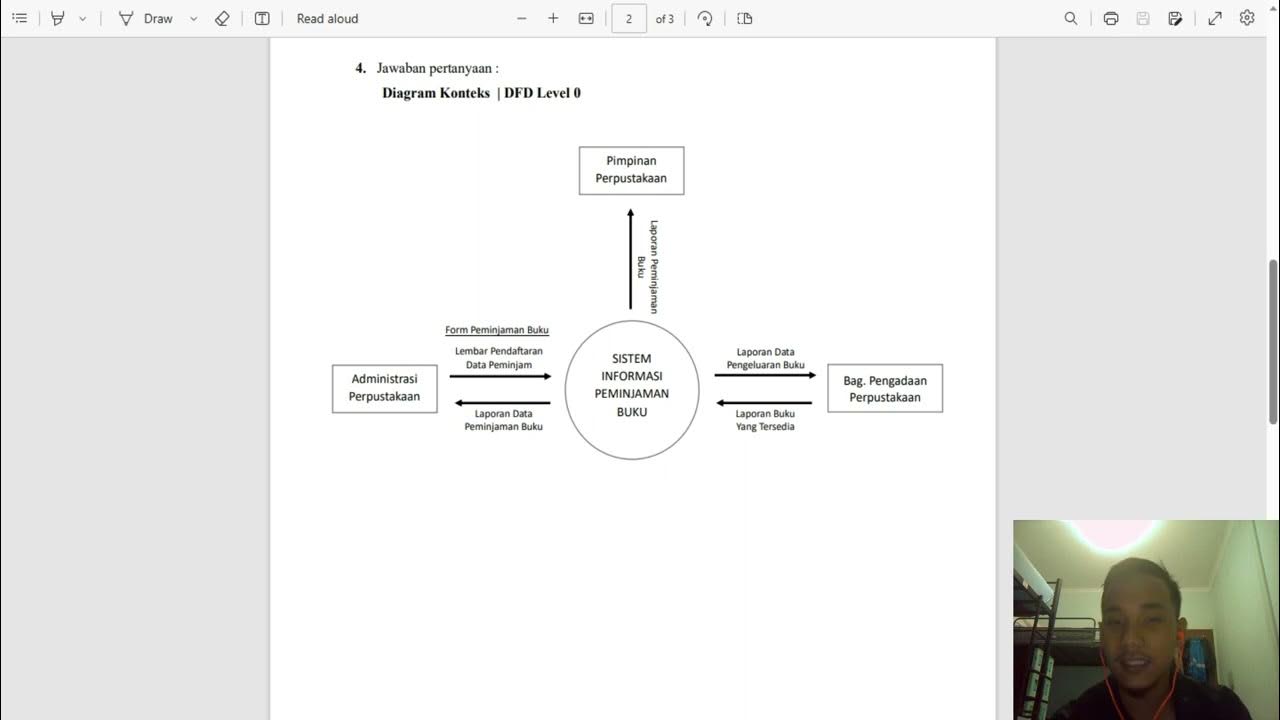What is DFD ? Full Explained With Example Library Management System DFD | Don't Miss
Summary
TLDRIn this video from Karishma Classes, the concept of a Data Flow Diagram (DFD) is explained in detail. The instructor begins by introducing DFDs, explaining their use in representing the flow of data in systems like Library Management Systems. The video walks through various DFD levels, starting from zero-level diagrams and progressing to first and second levels. Examples, such as managing student book requests in a library, are used to illustrate key points. The instructor emphasizes how DFDs simplify understanding system components and processes. Viewers are encouraged to like, share, and subscribe for more educational content.
Takeaways
- 📘 The video introduces the topic of Data Flow Diagrams (DFD) and how they represent the flow of data in systems.
- 📊 DFD helps visualize the input, output, and processing of data within a system in a simple way.
- 🔍 The example used is a Library Management System, where the student, library card, and book display are key components.
- 📚 The first step in the DFD for the library system is when a student requests a book using a library card.
- 🖥️ The DFD shows how the book search process works, detailing how book information is retrieved and displayed to the student.
- 🔄 The second level of the DFD goes deeper, showing how the book request is processed and matched with relevant book details (e.g., author, title).
- 📑 The third level DFD focuses on book issuance, updating the system with details like issue date, student info, and the book's status.
- 🛠️ The DFD also highlights the role of book shelving, where the system finds the book's position based on its title and author.
- 💡 The video emphasizes that each DFD level adds more detail to the process of managing books within the library system.
- 🔔 Viewers are encouraged to like, subscribe, and click the notification bell for future videos covering more topics in detail.
Q & A
What is a Data Flow Diagram (DFD)?
-A Data Flow Diagram (DFD) is a representation of the flow of data within a system. It shows how data moves in and out of the system, as well as the processes that handle this data.
Why is a DFD used in system analysis?
-A DFD is used to depict the flow of information in a system, making it easier to understand the key components, inputs, and outputs. It provides a visual representation of how data moves through different processes, helping with system design and analysis.
What are the main components of a DFD?
-The main components of a DFD are external entities (sources and destinations of data), processes (which transform data), data stores (where data is held), and data flows (the movement of data between entities, processes, and stores).
What example is used to explain the DFD in this video?
-The example used to explain the DFD in this video is a Library Management System, which involves components like students, library cards, book search, and book borrowing processes.
How is the Library Management System represented at Level 0 of the DFD?
-At Level 0 of the DFD, the Library Management System is simplified into basic components like the student, the library card, and the book search. It shows how a student requests a book using a library card and how the system searches for the requested book.
What happens in Level 1 of the DFD for the Library Management System?
-In Level 1 of the DFD, the Library Management System is detailed further. The process of requesting a book is broken down into more specific tasks, such as searching by topic, finding book information (author, title), and delivering the requested book to the student.
What is explained in Level 2 of the Library Management System DFD?
-In Level 2 of the DFD, the system details how the book is issued to the student. It includes updating records with book issue information, including the student’s details and the book’s author, title, and shelf location.
How does the system handle book requests and delivery according to the DFD?
-The system handles book requests by searching for the book based on the student's input (topic, author, etc.), finding the book's location, and then delivering the book to the student. The entire process is visually represented in the DFD at different levels.
What is the significance of detailing different DFD levels?
-Detailing different DFD levels helps in breaking down the complexity of the system into smaller, manageable parts. Level 0 provides an overview, while subsequent levels (Level 1, Level 2) offer more detailed insights into specific processes within the system.
Why is it important to use clear and simple terms in a DFD?
-Using clear and simple terms in a DFD ensures that the diagram is easily understood by all stakeholders, including those who may not have a technical background. This helps in effective communication during system analysis and design.
Outlines

This section is available to paid users only. Please upgrade to access this part.
Upgrade NowMindmap

This section is available to paid users only. Please upgrade to access this part.
Upgrade NowKeywords

This section is available to paid users only. Please upgrade to access this part.
Upgrade NowHighlights

This section is available to paid users only. Please upgrade to access this part.
Upgrade NowTranscripts

This section is available to paid users only. Please upgrade to access this part.
Upgrade NowBrowse More Related Video

Diagram Konteks | DFD Level 0 dan DFD Level 1 | Sistem Informasi Peminjaman Buku

Chapter 7 Session 4 Part II: Stonehurst Place Example: Connecting Human Interfaces and DFD-0

What is DFD? How to design DFD, Symbols, examples full explanation

Tutorial Membuat DFD (Data Flow Diagram) | Studi Kasus Koperasi

Data Flow Diagram Level 0 | Analisis dan Desain Sistem

Data Flow Diagram (DFD): Definisi, Sejarah, Notasi, Tahap dan Tipsnya.
5.0 / 5 (0 votes)